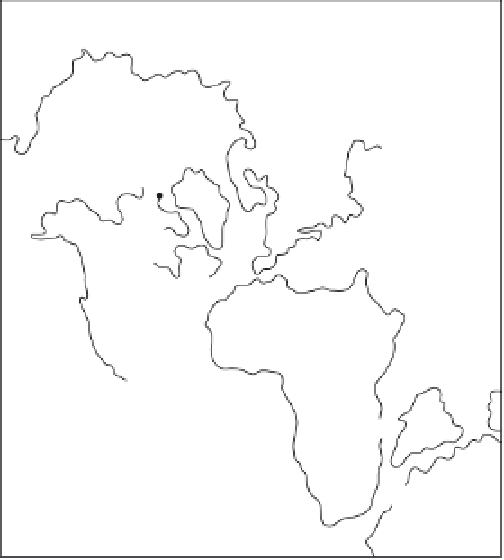Geoscience Reference
In-Depth Information
the distribution of continents and oceans and
shows little trace of the ocean-ridge system. Resid-
ual geoid highs, however, correlate with regions
of anomalously shallow ocean floor and sites of
extensive Cretaceous volcanism.
The lack of correlation of the large geoid
anomalies to present-day plate boundaries and
tectonics requires that the anomalies reflect
a deep-mantle structure that is unrelated to
plate tectonics, or, perhaps, to an ancient con-
figuration of plates. The correspondence of the
Atlantic--African anomaly with the Mesozoic con-
tinental assemblage and of the antipodal cen-
tral Pacific anomaly with extensive Cretaceous
volcanism in the Pacific is suggestive, but may
be coincidental. Surface-wave tomography shows
a good correlation of intermediate-wavelength
geoid highs and slow regions of the upper man-
tle. However, the very-long-wavelength compo-
nents of the geoid correlate best with tomog-
raphy of the lower mantle. Most of the present
continents, except Africa, and most of the
present subduction zones (except Tonga--Fiji)
are in long-wavelength geoid lows and there-
fore probably overlie denser than average lower
mantle.
The
Atlantic-African geoid high
extends from Iceland through the north Atlantic
and Africa to the Kerguelen plateau and from
the middle of the Atlantic to the Arabian
Peninsula and western Europe (Figure 6.3).
Most of the Atlantic, Indian Ocean, African and
European hotspots are inside this anomaly, but
so are spreading ridges. The hotspots Iceland,
Trinidade, Tristan, Kerguelen, Reunion, Afar,
Eiffel and Jan Mayen form the 20-m boundary
of the anomaly and appear to control its shape.
The Azores, Canaries, New England seamounts,
St. Helena, Crozet and the African hotspots are
interior to the anomaly.
Although the geoid high cuts across present-
day ridges and continents, there is a remarkable
correspondence of the pre-drift assemblage of
continents with both the geoid anomaly and
hotspots. Reconstruction of the mid-Mesozoic
configuration of the continents reveals, in addi-
tion, that virtually all of the large shield areas
of
Jan Mayan
Iceland
Eifel
Azores
Canary
20 m
New England
40 m
Verde
St. Helena
Reunion
Crozet
Tristan
Kerguelen
Bouvet
Fig. 6.3
The Pangea and Atlantic--Africa geoid high plotted
relative to the 200 Ma (200 million years ago) positions of the
continents and hotspots.
high (Figures 6.1 and 6.3). These include the
shield areas of Canada, Greenland, Fennoscandia,
India, Africa, Antarctica and Brazil. Most of the
Phanerozoic platforms are also in this area. In
contrast, today's shields and platforms are con-
centrated near geoid lows. They may have drifted
into, and come to rest over, these geoid lows. The
area inside the geoid high is also characterized
by higher-than-normal elevations, for example in
Africa, the North Atlantic and the Indian Ocean
southeast of Africa. This holds true also for the
axial depth of oceanic ridges.
Large plates insulate the mantle and allow
radioactive heat to build up. When a supercon-
tinent -- or super oceanic plate -- breaks up, we
expect active volcanism in the wake, both at
newly opening ridges and intra-plate settings.
This is the result of extensional stress as well
as high fertility at former sutures and higher
temperatures. This may also trigger delamina-
tion and foundering of the deeper portions
of over-thickened continental crust, and uplift.
These phenomena at new plate boundaries and
the edges of continents are often attributed to
the
world
are
contained
inside
the
geoid
























